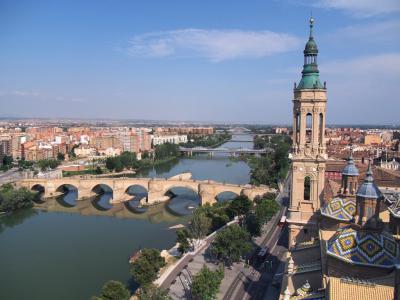Puente de Piedra (Stone Bridge), Zaragoza
The Stone Bridge is a historic and iconic structure that spans the majestic river Ebro in Zaragoza. This bridge, often referred to as the Bridge of Lions, earned its unique nickname from the addition of four lion statues, symbolizing the city, which were installed on the bridge's pillars in 1991. The distinctive lion statues were masterfully crafted by Francisco Rallo Lahoz.
The history of the Puente de Piedra dates back to the 12th century when the citizens of Zaragoza first endeavored to construct a bridge that would gracefully traverse the flowing waters of the Ebro. However, it wasn't until the years 1401 to 1440 that the bridge, as we know it today, began to take shape. The construction was carried out under the supervision of the skilled architect Gil de Menestral.
Over the centuries, the bridge has faced challenges, notably the devastating flood of 1643, which resulted in the destruction of two central spans of the bridge. This critical moment in the bridge's history left it resembling the image captured in the famous painting "View of Zaragoza" by Juan Bautista Martínez del Mazo in 1647.
In 1659, the people of Zaragoza undertook the task of reconstructing the bridge. The brilliant architect Felipe de Busignac led the effort, restoring the two towers that had been destroyed and expanding the bridge's piers. A significant restoration took place in 1789 when architect Agustín Sanz strengthened the Ebro's banks near the Monastery of St. Lazarus, ensuring that the risk of flooding would no longer threaten the bridge.
The history of the Puente de Piedra dates back to the 12th century when the citizens of Zaragoza first endeavored to construct a bridge that would gracefully traverse the flowing waters of the Ebro. However, it wasn't until the years 1401 to 1440 that the bridge, as we know it today, began to take shape. The construction was carried out under the supervision of the skilled architect Gil de Menestral.
Over the centuries, the bridge has faced challenges, notably the devastating flood of 1643, which resulted in the destruction of two central spans of the bridge. This critical moment in the bridge's history left it resembling the image captured in the famous painting "View of Zaragoza" by Juan Bautista Martínez del Mazo in 1647.
In 1659, the people of Zaragoza undertook the task of reconstructing the bridge. The brilliant architect Felipe de Busignac led the effort, restoring the two towers that had been destroyed and expanding the bridge's piers. A significant restoration took place in 1789 when architect Agustín Sanz strengthened the Ebro's banks near the Monastery of St. Lazarus, ensuring that the risk of flooding would no longer threaten the bridge.
Want to visit this sight? Check out these Self-Guided Walking Tours in Zaragoza. Alternatively, you can download the mobile app "GPSmyCity: Walks in 1K+ Cities" from Apple App Store or Google Play Store. The app turns your mobile device to a personal tour guide and it works offline, so no data plan is needed when traveling abroad.
Puente de Piedra (Stone Bridge) on Map
Sight Name: Puente de Piedra (Stone Bridge)
Sight Location: Zaragoza, Spain (See walking tours in Zaragoza)
Sight Type: Attraction/Landmark
Guide(s) Containing This Sight:
Sight Location: Zaragoza, Spain (See walking tours in Zaragoza)
Sight Type: Attraction/Landmark
Guide(s) Containing This Sight:
Walking Tours in Zaragoza, Spain
Create Your Own Walk in Zaragoza
Creating your own self-guided walk in Zaragoza is easy and fun. Choose the city attractions that you want to see and a walk route map will be created just for you. You can even set your hotel as the start point of the walk.
Zaragoza Introduction Walking Tour
Although somewhat lesser-known a city (compared to Barcelona or Madrid), the capital of the Aragon region, Zaragoza, bears witness to a rich tapestry of historical influences which makes it an authentic Spanish treasure. Nestled along the serene banks of the Ebro River, it has been an essential crossroads of cultures since time immemorial.
The origins of this Spanish city go back to the... view more
Tour Duration: 2 Hour(s)
Travel Distance: 2.0 Km or 1.2 Miles
The origins of this Spanish city go back to the... view more
Tour Duration: 2 Hour(s)
Travel Distance: 2.0 Km or 1.2 Miles




